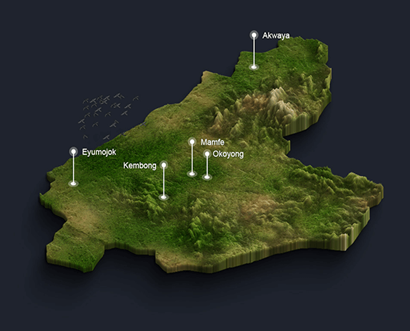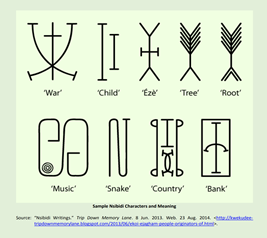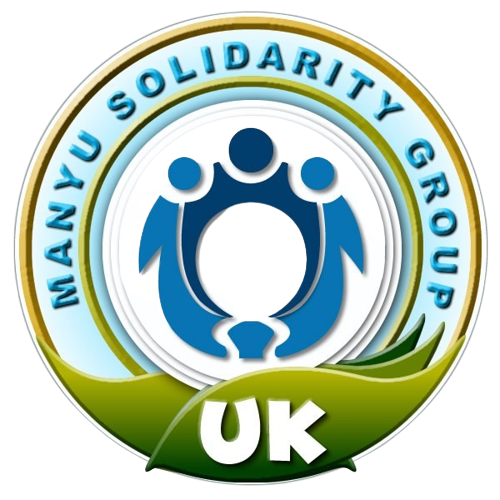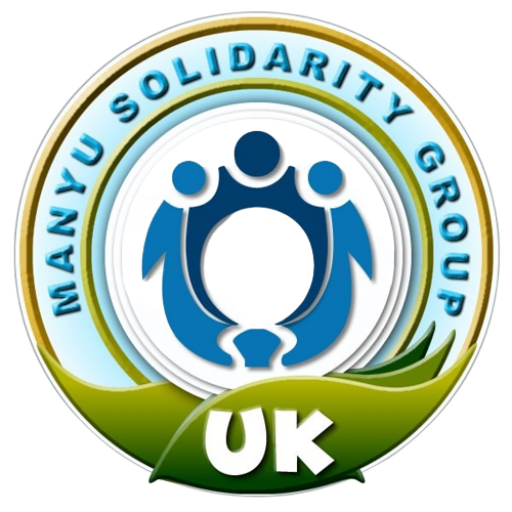A Brief Anthropological History of Manyu
Manyu is a nation in the state of Cameroon, Central Africa. Situated in the Upper Cross River Basin, Manyu Division stretches northwards from the Widikum escarpment of the western grass fields through the rolling Obudu hills, climbing northwards to the Ntaire (Mbio) mountains and descending south-westwards to the Ossidinge (Mamfe) depression, through the Cameroon-Nigeria border regions of Ikom Division and the Oban District of the Federal Republic of Nigeria, and south-eastwards to the Manyu River Valley. Administratively, Manyu Division encompasses Mamfe Central, Upper Banyang, Eyumojock and the Akwaya Sub-Divisions of the South West region of the Republic of Cameroon. This region lies within the Equatorial zone and has an equatorial rainforest climate and vegetation.
The climate is characterized by two distinct seasons –the dry season and the rainy season. The dry season extends for six months, from December to May, characterized by low conventional rainfall, with high atmospheric temperatures, and a mean annual temperature of about 25 degrees Celsius (25°C). During this period, the prevailing monsoon winds are dry with abundant sunshine. The rainy season lasts approximately for about six months, stretching from March – to October. The peak of the rainy season being towards late June, July and August with annual rainfall figures reaching 6000mm in some areas, and a general annual average range between 2700mm and 3600mm per annum.


Covering an area of 9,565 km2, Manyu Division has over 500,000 people with Mamfe as its administrative capital. The Manyu people live in clan settlements in a large, sparsely populated area in the tropical rainforest area of the country. The population of the Anyang, Banyang and Ejagham is Black African and their origin remains an area of study that requires proper historical research. Some early researchers (Talbot 1912), hold that these people are of Egyptian origin, while others believe, they come from Central Africa. More recent research (Haywood 2008), on the Bantu of Africa among whom the Manyu groups fall, shows that the [Bantu] originated from the rain forest of southern Nigeria and Cameroon sometimes around 3000 BC. This group then split into various sub-groups with easterly and westerly fronts. From around 2500 BC, the eastern groups began migrating eastwards following the northern edge of the rainforest of the Congo River Basin into southern Sudan. Other subgroups moved southwards into the east African Great Lakes Region around the time of Christ. Meanwhile, the western front groups migrated southwards reaching the lower Congo Basin by 400 BC.
From the above research findings, one thing remains clear – that the original homeland of the Bantu is somewhere in and around the rainforest region of southern Nigeria and Cameroon. From this point of origin, the Bantu then disintegrated into various groups migrating to various directions. From the major groups (eastern and western), emerged several other sub-groups and the Bantu migrations were therefore a complex movement of Bantu sub-groups. Archaeological evidence indicates that the Manyu people first settled in their presentday land circa 170 A.D. The Ikom monoliths of the Cross River regions in neighbouring Nigeria, which were constructed between 270 B.C to 170 A.D, suggest the Manyu people were able to develop the Nsibidi script.
The Nsibidi script is an ancient system of artistic symbols referred to as Nsibiri. The script debunks the notion that information dissemination in precolonial Africa was only through traditional oral channels. Africa’s oldest language scripted from behind hieroglyphics, Nsibidi, has been used to document history, celebrate the people’s heritage, instruct values, reinforce communication, deliberate on critical issues and resolve conflicts. The Ejagham people first created the script in Manyu. In ancient times, the government of the Manyu nation was the Mgbe or Ekpe fraternity, which is a patriarchal organization. The Mgbe kept the nation together in peace and harmony for millennia. Mgbe used the Nsibidi script as one of its methods of communication, and members of the Ekpe society today still communicate using this ancient language. There are more than 100 established community groups in Manyu, but the predominant clans are Banyangs, Ejaghams, Anyangs and Boki people. These groups in Manyu have a patrilineal organization. The nation has more than 100 villages, each governed by a council of elders with the Chief at the head of the structure.
Ethnologically, Manyu encompasses an array of ethnic groups. In the Anyang region of Akwaya sub-Division, we have the following main groups: Anyang (Anyang, Anyam, Eyan, Nyang, Oboyan), Asaka (Massaka), Basua, Batanga, Bazumbo, Boki (Nki, Okii, Fua, Osukum, Vaaneroki), Eman, Esimbi, Evant,
Ndir, Ukwese, Utang and Yon. In the Banyang region of Mamfe Central and Upper Banyang sub-Divisions, we have the Banyang (Banyang, Anyang, Banyangi, Bajangi, Manyang). The Banyang ethnic group is sub-divided into two groups; the Upper Banyang and the Lower Banyang. In the Ejagham region of Eyumojock Sub-Division, we have the Ejagham (Edjagham, Ekwe, Qua, Etung, Abakpa, Abakwa, Carabali, Ajághá, Bayághá, Ekin, Keaka, Eeafeng, Obang). The Ejagham ethnic group is sub divided into three groups; Ekwe (Ejagham, Que, Abakpa, Abakwa, Njemaya, Carabali); Keaka (Ajághá, Edjagam, Eeafeng, Bayághá, Ngunaya) and Obang (Evang).
Traditionally, Manyu people engage in full-time agriculture; women concentrate on subsistence farming while men grow cash crops, mainly cocoa and coffee. Before the arrival of the Europeans for slave trade and colonization, Manyu was a vibrant economic environment using its many rivers as one of their means of transportation. When the German, Dr Max Esser, arrived in Manyu in 1896 alongside Eugen Von Zintgraff and Victor Hoersch, he described the Manyu people comprising the Banyangs, Ejaghams, Anyangs as self-confident, industrious, and friendly; who lived like an extended family with similar names. The Germans grouped these communities, and later the British colonial authorities maintained the same structure, but after “independence”, the community structure, especially in Banyang areas, slowly dissolved. The richness and vastness of Manyu culture and history are unquestionable.
The traditional meal of the Manyus is fufu and eru; which has been exported to other nations and areas of Cameroon and has become the country’s national delicacy. In Cameroon, the Manyu people are regarded as one of the most educated nations. Despite most families being dependent on subsistence farming, their earnings are readily invested in their children’s education. The main form of religious worship in Manyu is Christianity, with Islam and African Traditional religion (Animism) also practised.


